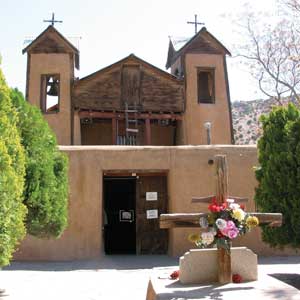|
GEOLOGIC COLUMN
The Magic in Dirt
Lisa A. Rossbacher and Dallas D. Rhodes
 Lisa A. Rossbacher |
El Santuario de Chimayó in New Mexico was built in 1816 upon the site where a cross is said to be buried. The soil of the cross’ shrine is believed to have healing powers. |
Geologists know that there is magic in dirt. Weathered rocks and minerals mixed with variable amounts of organic matter are among the most valuable substances on the planet: Soil, water and sunlight are the sources of our food and are essential for our health. But in some places, soil nurtures the spirit as well as the body.
One of these places is Chimayó, a village nestled in the Sangre de Cristo Mountains of New Mexico. This is one of the Southwest’s oldest Spanish communities: Ancestors of current residents introduced weaving skills to the area about the same time the first English families arrived at Jamestown four centuries ago.
According to local legend, on the evening of Good Friday in 1810, a local holy man, Don Bernardo Abeyta, saw a light coming from a terrace of the Santa Cruz River. He dug into the soil to find the source of the light and discovered a wooden crucifix. Don Abeyta collected his neighbors in the village and brought them to the site. The villagers reported their finding to Father Sebastian Alvarez, Santa Cruz’s local priest, and brought him back to Chimayó. Father Sebastian picked up the crucifix and led a procession to the church in Santa Cruz, where the discovery was enshrined on the main altar.
The next morning, the cross had disappeared. It was later found in its original location in Chimayó. Another procession brought it back to Santa Cruz, only to have it reappear again by the river. After a third failed attempt to relocate the cross, everyone concluded that it was meant to stay in Chimayó. So, Don Abeyta built a chapel, El Santuario de Chimayó, on the spot where the cross was discovered and where it remains today. The exact location of the discovery is marked by a sign that says “El Posito,” which some have translated as “the pit” or “the well.”
If you don’t like that story, here’s another version. A Guatemalan priest from the town of Esquípulas came to Chimayó with a group of settlers, bringing with him a large crucifix. He was killed by the natives and buried along the Santa Cruz River. When the river flooded in 1810, the priest’s remains and his crucifix were exposed as dirt eroded from the bank. Some of the older residents recognized the priest, and his crucifix came to be called “Our Lord of Esquípulas.” A few years later, Don Abeyta asked Father Sebastian for permission to build a church on the site.
Older histories identify Chimayó as a place that was sacred to the Tewa Indians long before the Guatemalans or Spaniards arrived in the Sangre de Cristo Mountains. A spring located on the site where the cross was later found is said to have healing powers.
Pick the version you like best.
But in all the stories, for reasons that are lost to history, the mystical power of the shrine at Chimayó is in the dirt rather than the cross. The dirt from El Posito is considered by some to have healing powers. This fine-grained, sandy, red and tan clay is mixed with water, and then the mud is eaten or rubbed on the skin. Dozens of abandoned crutches, baby shoes and eye patches line a small room adjacent to the pit. Incredibly, although everyone is encouraged to take a sample, El Posito never empties. Sometimes the pit has a trowel in it. On other days, it contains just a plastic spoon. A number of local shops sell special containers for the dirt.
A sign on the wall of El Santuario de Chimayó says:
Please
This earth is blessed
Do not play in it
Thank you
Most of the nearly 300,000 people who visit the shrine each year collect a sample of its soil.
Before the cross was discovered in Chimayó, native peoples and then the Spanish came to this area because the soil, if not necessarily magic, was fertile, and the nearby Santa Cruz River provided water for irrigation. The Tewa learned to cultivate the soil and plant crops. The chiles that are now grown in abundance near Chimayó ripen to a deep red in the autumn and are a major ingredient in some of the region’s cuisine.
Before the Spanish brought their stories, the Tewa had their own tales that helped make sense of the world around them. The character of Coyote the Trickster appears in many Native American cultures, sometimes as the creator, sometimes as a source of trouble, but always with a moral. One story tells of how Coyote taught the people to harvest and preserve chile peppers so that the warm summer sun could burn again in the cold, dark winter.
Coyote obviously knew about the magic of soil and water — and peppers. Mystical places acquire layers of explanation. Believe whichever layer you wish — or all of them.

 Subscribe
Subscribe


